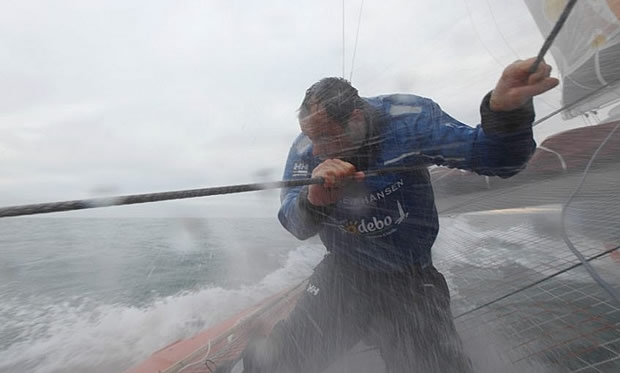
1000 miles behind
Thomas Coville sounds like he is in the next room when we spoke to him this morning, some 620 miles southeast of the Cape of Good Hope. During the conversation there are occasional breaks and the sound of groaning winches as he eased the main sheet, but thankfully conditions have changed on board – Sodebo is no longer sailing powered by gale force winds driving through a confused sea state just ahead of a front, conditions where in a 50 knot gust yesterday, the 32m (105ft) long trimaran buried her bows into a wave with such force that it saw her transoms pointing vertically in th air, nearly a full pitchpole (making the incredible video from the start in Brest look positively safe).
“You know if you have been sailing on multihulls, it can happen,” said Coville of the prospects of his trimaran flipping. “But nobody sees it normally. It is really rare that a photographer or a helicopter is close to us when we do such a thing. In Brest it was very special conditions, to cross the line you have to be very close to the land and off Ushant you have a lot of tide and when I started it was wind against tide, so there was a very deep sea state and that is why I had a near pitchpole. But it is quite normal if you go really fast at the end of a wave you can just stop the boat, if the wave is very deep. But on Sodebo, it is very safe because we have a very long bow and we have very long floats and foils that are huge - to be safe in those conditions. I am never really scared on Sodebo."
He continues: “Everyone who sails on multihulls knows that they can capsize, be it on a Hobie cat, or on Groupama or Banque Populare or on Sodebo, you can capsize. ORMA 60s - they capsized in pretty much every transat. That is part of the game. If you leave land on a multihull there is always a danger of capsize, you have to know it can happen and you have to take care to try and prevent it. That is the difference between monohulls and multihulls. On monohulls if you make a mistake you can break something. On a multihull if you make one mistake you can capsize and you are dead. It is a huge difference, but that is the price you pay for the speed, to be faster. If you don’t want to pay that price you have to go with a keel.”
To clarify the point – and you can read more about these boats here – compared to an ORMA 60, Sodebo and Francis Joyon’s current solo non-stop around the world record holder IDEC 2, are very long and narrow compared to the previous generation of ORMA 60s. While the latter were virtually square, with occasionally more than 60ft beam to 60ft LOA, Sodebo is 105ft long, but just 55ft wide. Most of this extra length is in her long long, pointy bow so pitchpoling her is hard (famous last words). Meanwhile the narrow beam makes lateral capsize less likely – she is more inclined to fly a hull (which is fast) but if the hull comes out of the water too much, the amount of submerged daggerboard is reduced and in theory she should slide sideways. In theory.
The major feature of Coville’s attempt on Francis Joyon’s solo singlehanded non-stop round the world to date is that passing the Cape of Good Hope, with the outbound trip down the Atlantic and into the Indian Ocean compete, she is now more than 1200 miles astern of Joyon’s record pace. But as Coville says: “it is a really tough challenge to go around the world in less than 57 days. I knew before I left Brest, the way Francis went to Cape Leeuwin was perfect, and I couldn’t do better than him there.” Pause to ease main sheet...sound of groaning winch. He’s back: “I was expecting to be 500 miles behind him, but it is 1000 miles today. We haven’t had ideal conditions – I had bad conditions at the Doldrums and bad conditions rounding the St Helena high pressure, but that was the way I had to go and do my best.”
However Coville remains optimistic he can regain the lost ground on ‘virtual IDEC’: “If I keep going, and I am not more than 1000 miles behind at Cape Horn, I think I am in a good position to catch up a lot of miles coming up back up on my return up the South Atlantic. I am still focussed on the speed and what I am doing every day at every instant, It is pretty hard to do, it is not easy, but that is why I am here too. We will see. If I could answer that question now, it would be great!”
Aside from a bad Equator crossing, a much more circuitous route around the South Atlantic high meant that Sodebo sailed some 1000 miles more than IDEC, Coville reckons. “Actually Francis had the same conditions all the way from the Doldrums to Cape Leeuwin. I think he took two reefs and that was it! He was under the genniker all the way, which was amazing! I have been tacking many times, reefing and changing, furling and unfurling, etc but I can’t make my choice about the weather around St Helena. I have to do the best with what I have got. So that’s it.”
By way of illustration Coville points to the fact that IDEC was faster from Brest to the Cape of Good Hope than the 2005 Jules Verne Trophy record holder Orange 2. “Last year on Groupama, we were only six hours ahead of him when we arrived at the Cape of Good Hope and we were 10 on board and Groupama was the latest generation [boat]. So it is only a question of the weather when you arrive in this part of the round the world trip. We will see after Cape Horn.”
As mentioned the last four days have been a struggle but have been fast with average 24 hour speeds in the 23-24 knot range, but now Coville says he is into another transition, sailing upwind.
“It is all about the transitions,” he advises. “It is the way you go through transitions between the oceans, from the Doldrums to St Helena, from St Helena going into the Indian Ocean, etc and it will be the case until Cape Horn. If you have good transitions or [better still] no transitions and you keep going with the same system you make such big gains, you make a lot of miles. But for me all the transitions have been very tough, with strong winds and a lot of manoeuvres. Every time you have a bad transition you lose some time.”
In terms of himself, Coville says that he was able to sleep well (ie get 4 hours in every 24) in the lighter winds rounding the South Atlantic high, but over the taxing last four days, chased by the front in the Roaring Forties, he has been lucky to get his head down for two hours in every 24.
“For the moment I am in good shape. I am still pretty fit. I am tired of course...I need to have a bit of rest in the next couple of hours to be sure that the next low pressure in the Indian Ocean, which is huge one, I will be 100% and able to focus on it. So I have to manage how to recharge my batteries in the next few hours.”
This transition Coville hopes will put him into the right part of the next depression he mentions, for Sodebo to be able to ride it all the way to Cape Leeuwin at the southwestern corner of Australia. However it is going to be hard work.
“It is one of the big low pressures that we just hate when we are sailing around here. It is going to be a big fight. But it is pretty good what we have done on our weather routing. That could stay with us until Cape Leeuwin, which is a good challenge. It isn’t going to be an easy Indian Ocean, it is going to be tough with a lot of transitions and a lot of manouevring and some storms with more than 35-45 knots at times. So I know that it is going to be tough anyway. But again, I am not choosing the weather forecast!”
For reasons of safety Coville advises that his is not going to be tempted south, where the breeze is potentially more favourable and the route can be substantially shorter. “We are going to be safe on a north route, so that if there are any problems or if we feel that a low pressure is too dangerous, we can escape and come north and be safe. After that we will see what is happening in the rest of the Southern Ocean and hopefully the Pacific Ocean is going to be easier. I have no hopes.”
Another reason to stay north is ice – hence there reason there are so many mandatory ice waypoint gates in the Barcelona World Race. Coville says his team has been working with a French company that provides them with satellite observations of where ice is in the Southern ocean. One at present is south of the Cape of Good Hope, while another is presently around the Kerguelen Islands, mid-Indian Ocean. “So we won’t go south of the Kerguelen, but it seems that in the Pacific it is definitely clearer than it was in 2008 when I went there, which is good news for us. We may have the possibility to go further south in the Pacific. That would be a huge gain of time and distance if you go south. I am not going to go playing with the ice. Ice is only good for having a good whisky and even in whisky I don’t like ice!”
Despite the batten breakages which helped mess up his Doldrums crossing, Coville states that at present his giant trimaran is in “perfect shape. I am really proud of it and happy that I can say that everything on board is 100%. This is the goal. I need to have my boat at 100% until the end to be sure that I can push hard to beat that bloody time. I need to push hard without breaking anything, which is always a tricky point.”
Otherwise: “I am sailing day by day and I try to do my best. I am pleased to be on board. Actually I really enjoy manoeuvring on board and I enjoy sailing multihulls anyway and that is it. This is where I get my energy. It is still fantastic challenge to try and break this record. After the Route du Rhum I could have stayed at home and say ‘I’ve done the Route du Rhum’ and stay at home for the winter for it be my program, but every winter if you are not trying it is a winter that is lost, a winter you should have tried. That is my philosophy. That is why I was there last year with Groupama and who knows I might be there next year with the Volvo or any kind of boat.”
See more of Christophe Launay's images here
Click on images to enlarge them
 |
 |
 |
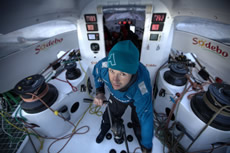 |
 |
 |
 |
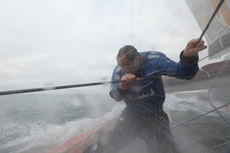 |
 |
 |
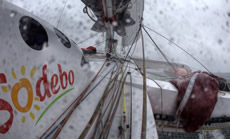 |
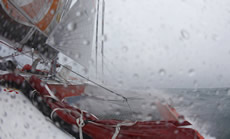 |
 |
 |
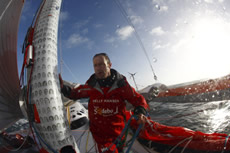 |
 |
 |
 |
 |
|









Latest Comments
Add a comment - Members log in